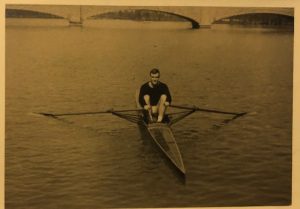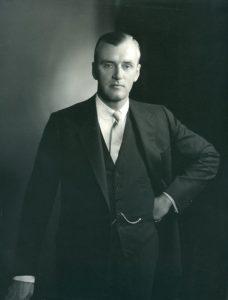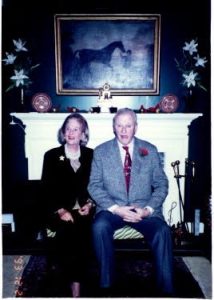Ever the perfect gentleman, lifelong Philadelphian William M. Hollenback, Jr. was a skillful sculler, a seasoned rowing official, a generous philanthropic supporter of the sport and a natural diplomat. In other words, exactly the right individual to lead the nascent national governing body of United States rowing through an era of dramatic reorganization and expansion.
From 1978 through 1986, under Bill’s leadership as its president, the National Association of Amateur Oarsmen (NAAO) became the United States Rowing Association, moving from an east coast cabal, to a broadly based inclusive national organization. In addition to registering the formal name change, the multi-year restructuring process involved adopting a nationwide regional system of administration and governance previously devised and implemented by the National Women’s Rowing Association (NWRA) and finally, in 1982, merging with the NWRA. It is now widely known by rowers everywhere by its operating trademark, USRowing.
The details of Bill’s development as a sculler are shrouded in the mists of time, but he must have become interested at some point in his teen years, in the mid to late 1930’s. An only child, he certainly did not follow in his father’s footsteps in his choice of sport. William M. Hollenback Sr. was a legendary footballer at the University of Pennsylvania who also experienced considerable success both in business and as a coach.
Beyond dispute is that Bill learned to scull on Boathouse Row, most probably at the University Barge Club, where he could have been mentored by any of several seasoned single scullers. Regardless, comparisons with his father’s sporting legacy chafed at Bill from time to time. For example, after he won a local singles race in the 1950’s, he was particularly irked by the caption to a short newspaper report of his victory that read: “Son of Penn Grid Great Wins Rowing Race.”
 Around 1940, however, college beckoned, and Bill did attempt to follow in his father’s footsteps by enrolling at Penn. But Hollenback Sr., though a prominent alumnus, decreed otherwise, categorically telling Bill “you’re going to Princeton.” Hence the genesis of a treasured piece of family ephemera, a yellowing newsprint photo of Bill sculling his single on Lake Carnegie.
Around 1940, however, college beckoned, and Bill did attempt to follow in his father’s footsteps by enrolling at Penn. But Hollenback Sr., though a prominent alumnus, decreed otherwise, categorically telling Bill “you’re going to Princeton.” Hence the genesis of a treasured piece of family ephemera, a yellowing newsprint photo of Bill sculling his single on Lake Carnegie.
After graduating in 1943, Bill enrolled in the United States Navy, and after reserve officers’ training was assigned to active duty in the Atlantic theater for the balance of World War II and a few subsequent years. It was during the latter period that Bill received his most memorable, albeit bittersweet, naval assignment. He served on the crew that took possession of a prized piece of war booty, the dangerously swift German armored battle cruiser Prinz Eugen, and sailed it to the United States.
Apparently, the ship handled beautifully at sea, and from a purely abstract point of view, the quality of its design and construction impressed many of the Americans aboard, including Bill. All the more bitter, then, was this vessel’s fate. A year or two later it was ignominiously towed to Bikini Atoll in the Pacific and all but obliterated in a U.S. atmospheric nuclear test.
Throughout the 1950’s, 1960’s and up to his retirement in the late 1970’s, Bill was actively involved in the family utility coal business, eventually taking full management responsibility for it after his father’s passing. Simultaneously, he continued his involvement in rowing, gradually moving from being an active competitor to sculling purely for pleasure, serving as president of the University Barge Club from 1954-1959, becoming a referee and gradually increasing his stature as a regatta official and supporter of various rowing organizations, including the NAAO. In addition, Bill served on the HOSR race committee in its formative years, taking on prominent roles as finish line judge and awards announcer.
In the early 1970’s, Bill made a substantial financial contribution toward a very necessary renovation of #4 Boathouse Row, in recognition for which the building was formally named “Hollenback House.” Prior to his gift – and for many years afterwards – the building served as the home base for several important entities, including the United States Rowing Society, the Schuylkill Navy of Philadelphia, the NAAO/USRA, and the Dad Vail  Rowing Association.
Rowing Association.
A serendipitous footnote to the above paragraph is that after another substantial renovation in the 2000’s the building has once again been revived as the home of its original occupant, the now resurrected Pennsylvania Barge Club, which, in the early decades of the 20th century had produced several Philadelphia-based rowing Olympians but had folded after World War II. In its new magnificence, the building continues to host the Schuylkill Navy, the Dad Vail, the Philadelphia Scholastic Rowing Association, the Pennsylvania Center for Adapted Sports, and now also houses the La Salle College High School and University rowing programs.
Bill’s long and multifaceted life contained many a milestone, but one that occurred in his golden years was of extra special significance: his marriage in the mid 1980’s to his longtime friend, the beautiful and gracious Maisie Cadwalader Worrall. It was a union that brought together two elegant individuals who shared many interests, great kindness, generosity, and a wonderful sense of humor, all of which deservedly brought them much joy in their extensive twilight years.
~Christopher Blackwall & John Basinski
We are celebrating the HOSR’s 50th anniversary by highlighting 50 legendary competitors/crews/teams/coaches/influencers that have catapulted the regatta into a fall classic over the last 50 years. We celebrate the people by passing down their stories through generations, and affecting change for the future of our sport. We will publish a new story each week, continuing the celebration of our 50th anniversary, leading up to the 2021 regatta.
